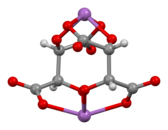Antimony potassium tartrate

| |
 Ball-and-stick model of the bis(μ2-tartrato)-di-antimony anion,[1][2] [Sb2(C4H2O6)2]2−
Carbon Hydrogen Oxygen Antimony | |
| Names | |
|---|---|
| Other names
potassium antimonyl tartrate
emetic tartar tartar emetic | |
| Identifiers | |
3D model (
JSmol ) |
|
| ChEBI | |
| ChemSpider | |
ECHA InfoCard
|
100.116.333 |
| EC Number |
|
| 1332600 | |
| KEGG | |
PubChem CID
|
|
| UNII | |
CompTox Dashboard (EPA)
|
|
| |
| |
| Properties | |
| K2Sb2(C4H2O6)2 · 3 H2O | |
| Molar mass | 667.87 g/mol |
| Appearance | white crystalline powder |
| Density | 2.6 g/cm3 |
| 8.3 g/100 mL (0 °C) 35.9 g/100 mL (100 °C) | |
| Hazards | |
| GHS labelling: | |
 
| |
| Warning | |
| Lethal dose or concentration (LD, LC): | |
LD50 (median dose)
|
110 mg/kg |
Except where otherwise noted, data are given for materials in their standard state (at 25 °C [77 °F], 100 kPa).
| |
Antimony potassium tartrate, also known as potassium antimonyl tartrate, potassium antimontarterate, or tartar emetic,
Medical
The first treatment application against
Tartar emetic was used in the late 19th and early 20th century in patent medicine as a remedy for alcohol intoxication, and was first ruled ineffective in the United States in 1941, in United States v. 11 1/4 Dozen Packages of Articles Labeled in Part Mrs. Moffat's Shoo-Fly Powders for Drunkenness.[12][13]
The New England Journal of Medicine reported[14] a case study of a patient whose wife secretly gave him a dose of a product called "tartaro emetico" which contained trivalent antimony (antimony potassium tartrate) and is sold in Central America as an aversive treatment for alcohol use disorder. The patient, who had been out drinking the night before, developed persistent vomiting shortly after being given orange juice with the drug. When admitted to the hospital, and later in the intensive care unit, he experienced severe chest pains, cardiac abnormalities, renal and hepatic toxicity, and nearly died. The Journal reports that "Two years later, he [the patient] reports complete abstinence from alcohol."
Emetic

Antimony potassium tartrate's potential as an emetic has been known since the Middle Ages. The compound itself was considered toxic and therefore a different way to administer it was found. Cups made from pure antimony were used to store wine for 24 hours and then the resulting solution of antimony potassium tartrate in wine was consumed in small portions until the wanted emetic effect was reached.[15][16][17]
The compound is still used to induce vomiting in captured animals in order to study their diets.[18][19][20]
Preparation, structure, reactions
Antimony potassium tartrate is prepared by treating a solution of potassium hydrogen tartrate and antimony trioxide:
- 2 KOH + Sb2O3 + (HOCHCO2H)2 → K2Sb2(C4H2O6)2 + 3 H2O
With an excess of tartaric acid, the monoanionic monoantimony salt is produced:[2]
- 2 KOH + Sb2O3 + 4 (HOCHCO2H)2 → 2 KSb(C4H2O6)2 + 2 H2O
Antimony potassium tartrate has been the subject of several X-ray crystallography studies.[21][22][23][24][25][2] The core complex is an anionic dimer of antimony tartrate (Sb2(C4H2O6)22-) which is arranged in a large ring with the
Further reading
Of historic interest:
- Frederick, George Mann (1952). Practical organic chemistry. England: Longmans, Green & Co. p. 115. ISBN 0-582-44407-1.
- Knapp, Fr. (1839). "Zur Bildungsgeschichte des Brechweinsteins". Annalen der Pharmacie. 32: 76–85. .
References
- doi:10.5517/cc89ghh.
- ^ .
- PMID 10951203.
- ^ .
- PMID 20974285.
- .
- ISBN 978-90-04-17541-9.
- PMID 3086114.
- PMID 13447130.
- S2CID 44279233.
- ^ Publishers, Bentham Science (October 1996). "The Antimonials". Current Medicinal Chemistry. pp. 304–305.
- ISBN 978-0-7607-3893-1. Retrieved 1 January 2013.
- ^ "United States v. 111/4 DOZEN PACKAGES, ETC..." Retrieved 1 January 2013.
- PMID 22808962.
- PMID 341167.
- PMID 19985185.
- PMID 19868716.
- JSTOR 1369067.
- JSTOR 27639314.
- JSTOR 27715221.
- .
- .
- .
- PMID 5467310.
- .
- ISBN 978-0-470-13237-1.
Further reading
- Priesner, Claus (1997). "Basilius Valentinus und die Labortechnik um 1600". Berichte zur Wissenschaftsgeschichte. 20 (2–3): 159–172. S2CID 170226309.
- Geoffroy, M.; Stack, T. (1751). "Observations on the Effects of the Vitrum Antimonii Ceratum, by Mons. Geoffroy, of the Royal Academy of Sciences, and F. R. S. Translated from the French by Tho. Stack, M. D. F. R. S". Philosophical Transactions. 47: 273–278. S2CID 186212284.
- Berzelius, Jöns Jacob (1824). Lehrbuch der Chemie.
- Copus, Martinus (1569). Das Spißglas in ein Glas gegossen, das man Vitrum Antimonii nennt, ein wahrhafftige Gift vnd gantzgeferliche Artzney sey.
- The Technologist. 1861.
- "Captain Cook's Antimony Cup" (PDF). Vesalius, VII, 2: 62–64. 2001.
- Schneider, R. (1859). "Ueber einige Antimon-Verbindungen". Annalen der Physik und Chemie. 184 (11): 407–415. .
- Groschuff, E. (1918). "Reines Antimon". Zeitschrift für anorganische und allgemeine Chemie. 103: 164–188. .
- Soubeiran, E.; Capitaine, H. (1840). "Zur Geschichte der Weinsteinsäure". Journal für Praktische Chemie. 19: 435–442. .
- Pfaff, C. H. (1838). "Ueber Antimon-Wasserstoffgas und die davon abhängige Unsicherheit des von James Marsh entdeckten Verfahrens zur Entdeckung des Arseniks". Archiv der Pharmazie. 64 (2): 169–174. S2CID 84920753.
- Zimmermann, E. (1930). "Das Antimon in der Chemotherapie". Klinische Wochenschrift. 9: 27–31. S2CID 43264526.
- Gress, Mary E.; Jacobson, Robert A. (1974). "X-ray and white radiation neutron diffraction studies of optically active potassium antimony tartrate, K2Sb2(d-C4H2O6)2·3H2O (tarter emetic)". Inorganica Chimica Acta. 8: 209–217. .



